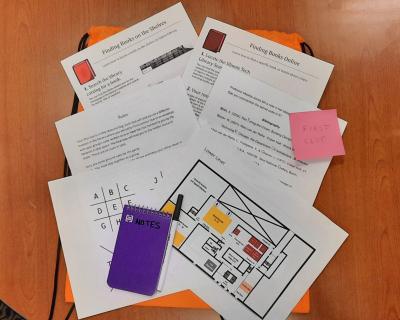In the summer of 2021, the Head of Reference and Instruction Services (RIS) at the Paul V. Galvin Library at the Illinois Institute of Technology reached out to the university’s First Year Experience Program (FYE) coordinator about a potential collaboration. One of the goals of the FYE program is to introduce incoming students to campus resources, services, and support so an introduction to the library seemed like a good fit. The FYE coordinator agreed as long as the content differed from what incoming students would see in new student orientation that each session run no longer than one hour. The Head of RIS agreed and asked the Information Literacy Librarian and the Online Learning and Instruction Librarian to work with her on the project.
Brainstorming
Once the team was assembled they began brainstorming possible learning goals eventually they settled on five:
- Students will be able to look up a book in the online catalog and find it on the shelf
- Students will be able to check out a book on reserve
- Students will become more comfortable asking librarians for help after interacting with friendly librarians during the game
- Students will be able to use the library’s website to find important information
- Students will become familiar with the library’s physical layout
The team then turned their attention to ideas for the program. They wanted something fun and different from a traditional library tour. During the pandemic, the Head of RIS had tried mystery games and escape rooms as a player and suggested those as possibilities. After some research and discussion, the team decided to create a mystery game.
Development
A mystery game requires a mystery and the team created one centered around a professor’s missing folder containing research for an article. Students had to solve clues and complete tasks in order to find the folder and return it to the professor. Six clues were created and each clue led students to a different space in Galvin Library: Group Study Suite, Stacks, Reserves, Research Help Office, University Archives and Special Collections, and the Kemper Gallery. The clues included:
- Bibliography with a hidden message
- Book cover puzzle
- Cipher
- Invisible ink clue
- Word scramble
- The first letter of each word in the description of a painting led students to Galvin Library’s art gallery where the folder was hidden
The librarians then created a team and location rubric. This rubric helped them visualize how the teams of students would be moving through the library during the game. Teams were each given a different starting clue and their routes through the library differed from each other to ensure that each team had to do their own work and not just follow another team. An accessibility-friendly route was also created for students with mobility issues.
Test runs were a crucial part of the development process. Teams of library student workers as well as librarians played the game and provided important feedback. Clues were fine-tuned based on this input and tested again. Test runs also helped with confirming that the games could be finished within the allotted amount of time.
The last step was to gather or create items for the resource bags that each team would be given at the start of the game. The drawstring bags, received from a vendor years ago, included:
- Rules sheet
- How-to handouts
- Cipher key
- First clue
- Map of the library
- Marker/pen
- Notebook
After completing the game each team received an I Solved the Mystery at the Library button, a library services flier, and an exit survey with the winning team members also receiving their choice of fidget toy.
Game Management
FYE mentors were responsible for scheduling a mystery game session for their cohorts. Sessions were scheduled via LibCal and email confirmations were sent to the mentors.
On game day the librarian team would run through the pre-game checklist 30 minutes prior to start time to ensure that each bag contained the correct first clue as well as all the other materials needed to play the game. The remaining clues, as well as hints, were distributed to librarians at various service points throughout Galvin Library.
When the students arrived at the library for the games they were divided into groups of 5, read the ground rules and the mystery story, given their resource bags, and off they went. The game was on!
Takeaways
A review of the exit surveys revealed that students not only enjoyed the game but commented on how they used soft skills such as listening and teamwork while playing it. A few of them even mentioned that librarians weren’t so scary after all!
Some challenges the librarian team encountered included communication issues with the FYE mentors, scheduling conflicts, and staffing issues as librarians returned to working on campus.
Overall the game required minimal staff, had little to no budget requirements, was a great collaboration opportunity with a campus partner, and was a lot fun for both librarians and students.
The plan is to offer the Mystery in the Library game again to a new crop of incoming students.
Today's guest blog post is by Nichole Novak, Head of Reference and Instruction Services, Illinois Institute of Technology Paul V. Galvin Library, Chicago, Illinois


